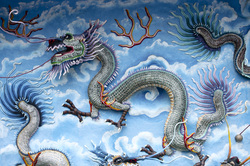Dragon Treasure Ornaments
Works by Loretta Hui-shan Yang, Chang Yi and Taiwanese modernist painter Liu Kuo-sung have all been acquired for a permanent collection in the VIP area of the China Pavilion at Expo Shanghai. The three pose together at the acquisition ceremony in Shanghai.

Chinese Dragon Introduction
The people of China have a long held belief that they are descendents of the dragon, a tradition that is firmly embedded in their culture and one that is encountered across all aspects of Chinese society and in the minds of its people. Whereas in western cultures dragons are usually regarded as a symbol of malevolence, in China the dragon is held in high esteem for its dignity and power for good.
From primitive times people have regarded the dragon as an auspicious creature with the power to bless and influence their lives. As tribes fought for domination and came to be united under a common banner the dragon was adopted as a national icon. Such was the mysterious creature's power it was regarded as the god of rain, thunder, the rainbow, and the stars. In a society that was founded upon agriculture and animal husbandry totally reliant upon its natural environment and in particular the climate, the dragon was worshipped as the source of all that was beneficial to communal well being. This concept has been sustained for thousands of years as more and more deification was bestowed upon the dragon ranging from being a bringer of joy to prophecy and miracles. With the establishment of a feudal society, emperors compared themselves to the dragon thereby making it the exclusive symbol of imperial majesty. Anyone who subsequently used the dragon as a symbol either intentionally or erroneously could be regarded as offending their ruler and condemned to death.